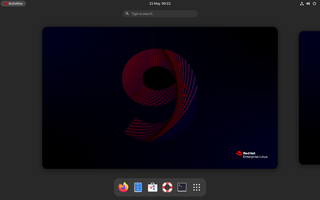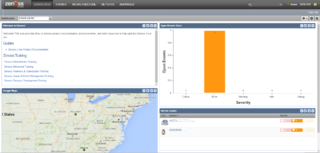
Squid is a caching and forwarding HTTP web proxy. It has a wide variety of uses, including speeding up a web server by caching repeated requests, caching World Wide Web (WWW), Domain Name System (DNS), and other network lookups for a group of people sharing network resources, and aiding security by filtering traffic. Although used for mainly HTTP and File Transfer Protocol (FTP), Squid includes limited support for several other protocols including Internet Gopher, Secure Sockets Layer (SSL), Transport Layer Security (TLS), and Hypertext Transfer Protocol Secure (HTTPS). Squid does not support the SOCKS protocol, unlike Privoxy, with which Squid can be used in order to provide SOCKS support.
Red Hat Network is a family of systems-management services operated by Red Hat. RHN makes updates, patches, and bug fixes of packages included within Red Hat Linux and Red Hat Enterprise Linux available to subscribers. Other available features include the deployment of custom content to, and the provisioning, configuration, reporting, monitoring of client systems.
up2date, also known as the Red Hat Update Agent, is a tool used by older versions of Red Hat Enterprise Linux, CentOS and Fedora Core that downloads and installs new software and upgrades the operating system. It functions as a front-end to the RPM Package Manager and adds advanced features such as automatic dependency resolution. The file /etc/sysconfig/rhn/sources specifies where up2date will search for packages.

Red Hat Enterprise Linux (RHEL) is a commercial open-source Linux distribution developed by Red Hat for the commercial market. Red Hat Enterprise Linux is released in server versions for x86-64, Power ISA, ARM64, and IBM Z and a desktop version for x86-64. Fedora Linux and CentOS Stream serve as its upstream sources. All of Red Hat's official support and training, together with the Red Hat Certification Program, focuses on the Red Hat Enterprise Linux platform.

MontaVista Software is a company that develops embedded Linux system software, development tools, and related software. Its products are made for other corporations developing embedded systems such as automotive electronics, communications equipment, mobile phones, and other electronic devices and infrastructure.

CentOS is a discontinued Linux distribution that provided a free and open-source community-supported computing platform, functionally compatible with its upstream source, Red Hat Enterprise Linux (RHEL). In January 2014, CentOS announced the official joining with Red Hat while staying independent from RHEL, under a new CentOS governing board.
WebSphere Application Server (WAS) is a software product that performs the role of a web application server. More specifically, it is a software framework and middleware that hosts Java-based web applications. It is the flagship product within IBM's WebSphere software suite. It was initially created by Donald F. Ferguson, who later became CTO of Software for Dell. The first version was launched in 1998. This project was an offshoot from IBM HTTP Server team starting with the Domino Go web server.

SUSE Linux Enterprise (SLE) is a Linux-based operating system developed by SUSE. It is available in two editions, suffixed with Server (SLES) for servers and mainframes, and Desktop (SLED) for workstations and desktop computers.
rPath, Inc. was a technology company based in Raleigh, North Carolina, that developed technology to automate the process of constructing, deploying, and updating software. rPath modeled and managed components and dependencies under version control. It acted as a model-driven and version-controlled repository, as well as a software distribution hub.

The company Zenoss, Inc. was founded in 2005 and is headquartered in Austin, Texas. The company develops hybrid IT monitoring and analytics software.
SUSE Linux is a computer operating system developed by SUSE. It is built on top of the free and open-source Linux kernel and is distributed with system and application software from other open source projects. SUSE Linux is of German origin, its name being an acronym of "Software und System-Entwicklung", and it was mainly developed in Europe. The first version appeared in early 1994, making SUSE one of the oldest existing commercial distributions. It is known for its YaST configuration tool.

Oracle Linux is a Linux distribution packaged and freely distributed by Oracle, available partially under the GNU General Public License since late 2006. It is compiled from Red Hat Enterprise Linux (RHEL) source code, replacing Red Hat branding with Oracle's. It is also used by Oracle Cloud and Oracle Engineered Systems such as Oracle Exadata and others.
The Red Hat Cluster includes software to create a high availability and load balancing cluster. Both can be used on the same system although this use case is unlikely. Both products, the High Availability Add-On and Load Balancer Add-On, are based on open-source community projects. Red Hat Cluster developers contribute code upstream for the community. Computational clustering is not part of cluster suite, but instead provided by Red Hat MRG.
This is a comparison of notable free and open-source configuration management software, suitable for tasks like server configuration, orchestration and infrastructure as code typically performed by a system administrator.

Fedora Linux is a Linux distribution developed by the Fedora Project. It was originally developed in 2003 as a continuation of the Red Hat Linux project. It contains software distributed under various free and open-source licenses and aims to be on the leading edge of open-source technologies. It is now the upstream source for CentOS Stream and Red Hat Enterprise Linux.

Microsoft Hyper-V, codenamed Viridian, and briefly known before its release as Windows Server Virtualization, is a native hypervisor; it can create virtual machines on x86-64 systems running Windows. Starting with Windows 8, Hyper-V superseded Windows Virtual PC as the hardware virtualization component of the client editions of Windows NT. A server computer running Hyper-V can be configured to expose individual virtual machines to one or more networks. Hyper-V was first released with Windows Server 2008, and has been available without additional charge since Windows Server 2012 and Windows 8. A standalone Windows Hyper-V Server is free, but has a command-line interface only. The last version of free Hyper-V Server is Hyper-V Server 2019, which is based on Windows Server 2019.
Spacewalk is open-source systems management software for system provisioning, patching and configuration licensed under the GNU GPLv2.
Oracle VM Server for x86 is the server virtualization offering from Oracle Corporation. Oracle VM Server for x86 incorporates the free and open-source Xen hypervisor technology, supports Windows, Linux, and Solaris guests and includes an integrated Web based management console. Oracle VM Server for x86 features fully tested and certified Oracle Applications stack in an enterprise virtualization environment.
The following outline is provided as an overview of and topical guide to the Perl programming language:
CloudStack is open-source Infrastructure-as-a-Service cloud computing software for creating, managing, and deploying infrastructure cloud services. It uses existing hypervisor platforms for virtualization, such as KVM, VMware vSphere, including ESXi and vCenter, XenServer/XCP and XCP-ng. In addition to its own API, CloudStack also supports the Amazon Web Services (AWS) API and the Open Cloud Computing Interface from the Open Grid Forum.








